Dive into a plate of homemade gluten-free gnocchi for dinner in less than 30 minutes! Made with only a handful of ingredients —whole milk ricotta cheese, gluten-free flour, olive oil, egg, and a little parmesan cheese — I love the simplicity of ricotta gnocchi because it’s fast and easy to throw together for dinner. Toss with desired sauce, and enjoy!
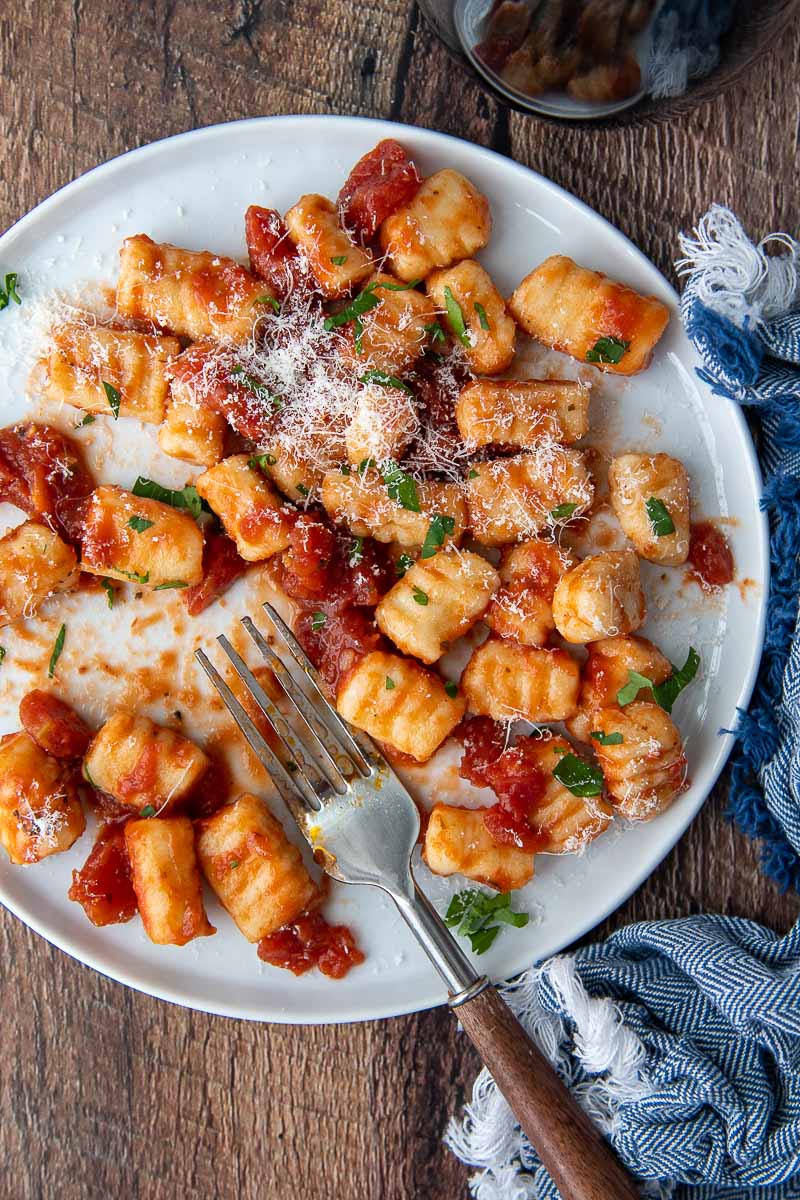
Well-Tested gluten-free gnocchi Recipe
Being raised in a first-generation Italian household meant shunning store bought-pasta. My Italian Gramma and mom cut fresh pasta for everything from simple family dinners to celebratory holiday meals.
Many of these Italian recipes have been adapted our family’s favorite gluten-free ideas for dinner just as good as I remember them, such as gluten-free lasagna, baked ziti, and focaccia.
While sadly Gramma was never able to give this gluten-free gnocchi recipe her stamp of approval, Mom and I give it an emphatic thumbs up and enjoy it with gusto! I particularly like it, because unlike Gramma’s gnocchi, there are no potatoes to peel, boil, or mash.
Instead of trying to replicate my family’s gnocchi recipe using gluten-free flour (believe me, I tried!), I transitioned to a ricotta cheese gnocchi. Why?
Through recipe testing I found that gluten-free gnocchi made with mashed potatoes tasted like, well, mashed potatoes. I believe this is due to the make up of GF flour blends, which rely heavily on rice flours. There wasn’t enough variance of the starches.
Using a base of gluten-free flour, mixed with ricotta, a little olive oil, egg, and parmesan decidedly improved both the taste and texture. Also, potato gnocchi adds a long extra step, plus the varying moisture content of potatoes doesn’t make for the best results.
As an added bonus, using ricotta in gluten-free gnocchi also means the prep is fast and easy. All the ingredients are mixed together in one bowl, roll, and then cut. It’s now possible to enjoy a homemade gnocchi recipe in less than 30 minutes.
Ingredient Notes
- Whole Milk Ricotta – I recommend whole milk ricotta, versus part skim, because the added fat makes the gnocchi more tender.
- Egg – Acts as a binding agent for the ingredients
- Olive Oil – Helps coat the GF starches to eliminate any gritty or graininess. You just need a touch.
- Parmesan Cheese – Also helps with binding and adds a nice flavor.
- Gluten-Free Flour – This gnocchi was tested with a variety of gluten-free flours with varying results. Therefore, I’ve included important recommendations and notes in the gluten-free flour section.
How to make Gluten-free gnocchi recipe
(Below shows step-by-step photos and modified instructions. For the complete recipe, along with ingredient amounts, scroll down to the recipe card.)
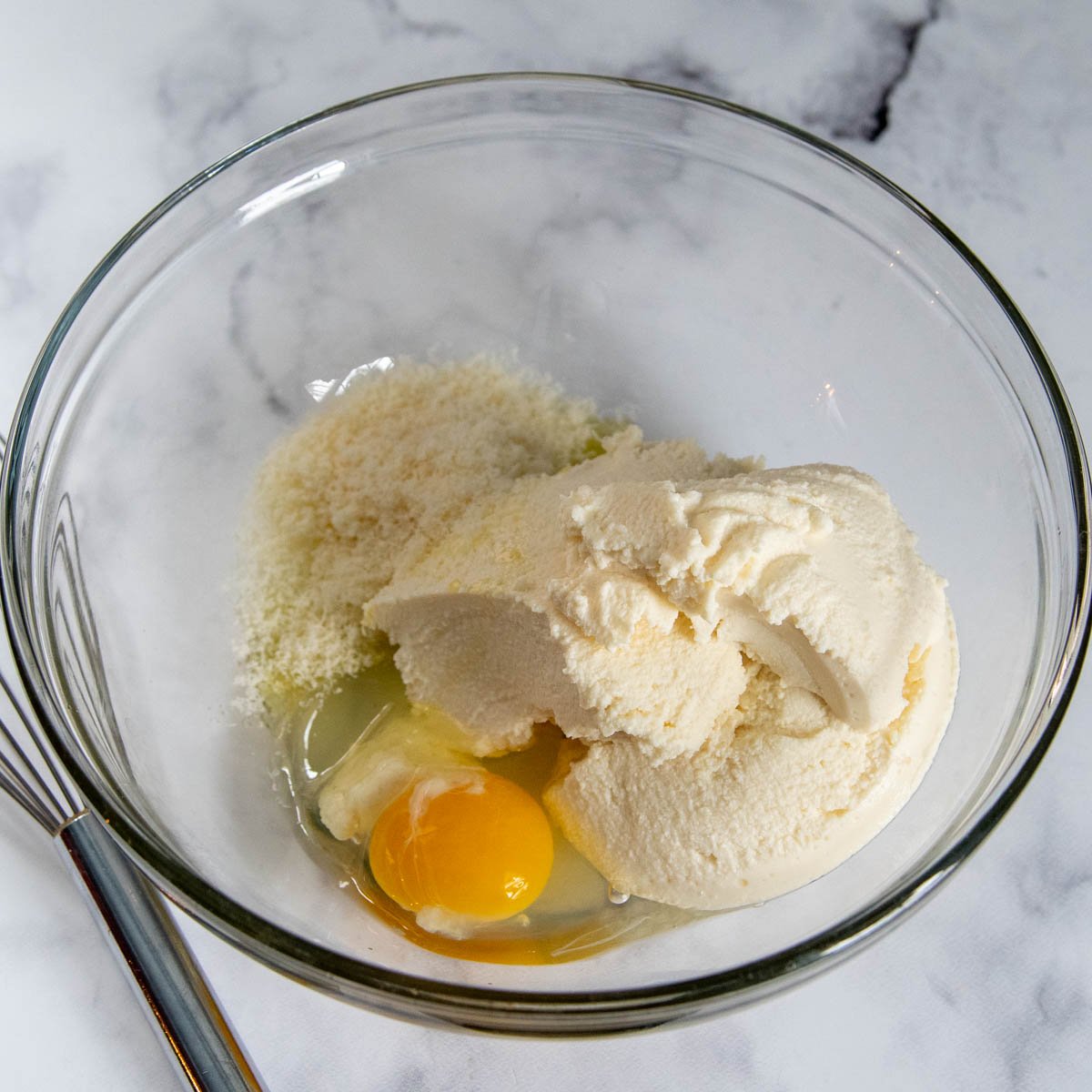
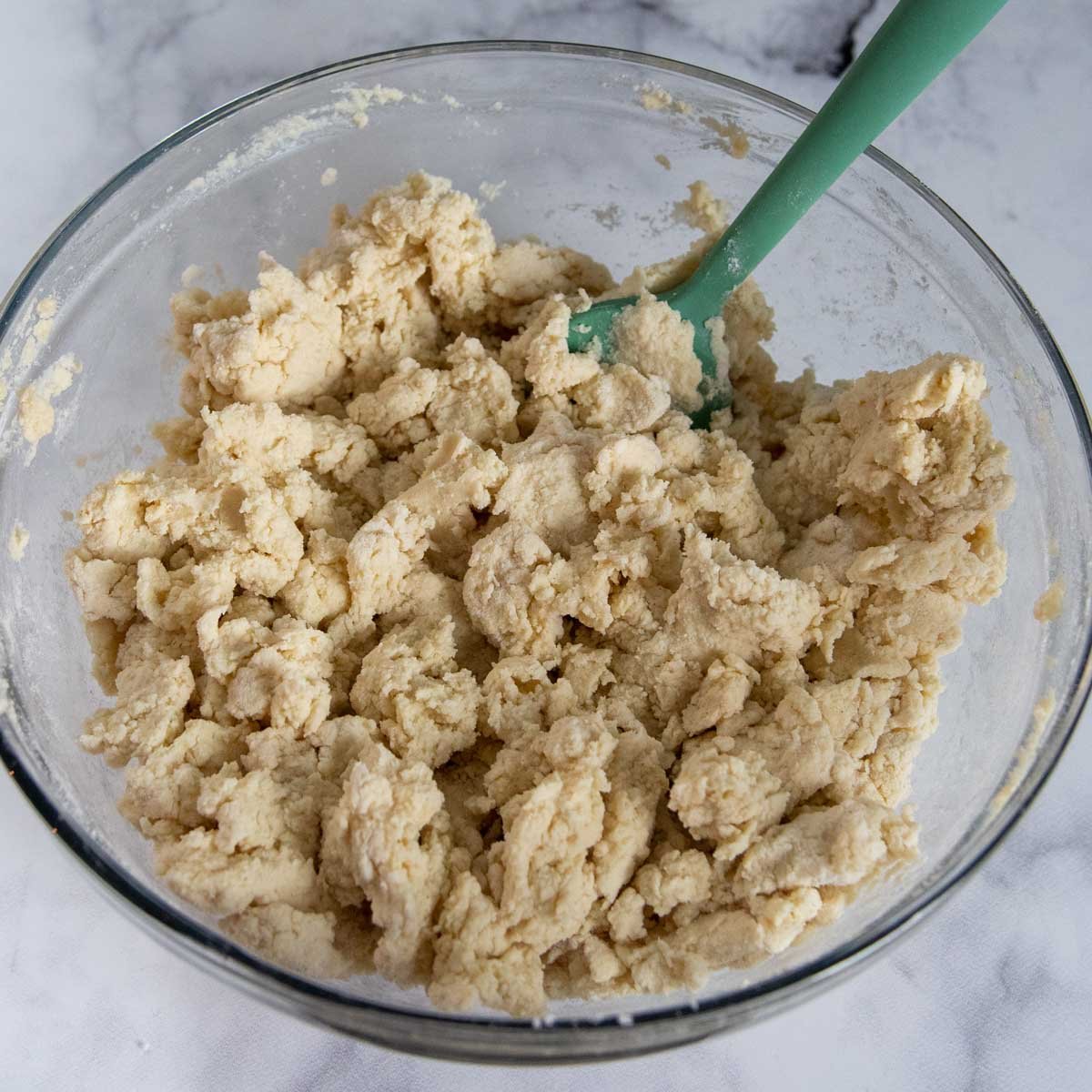

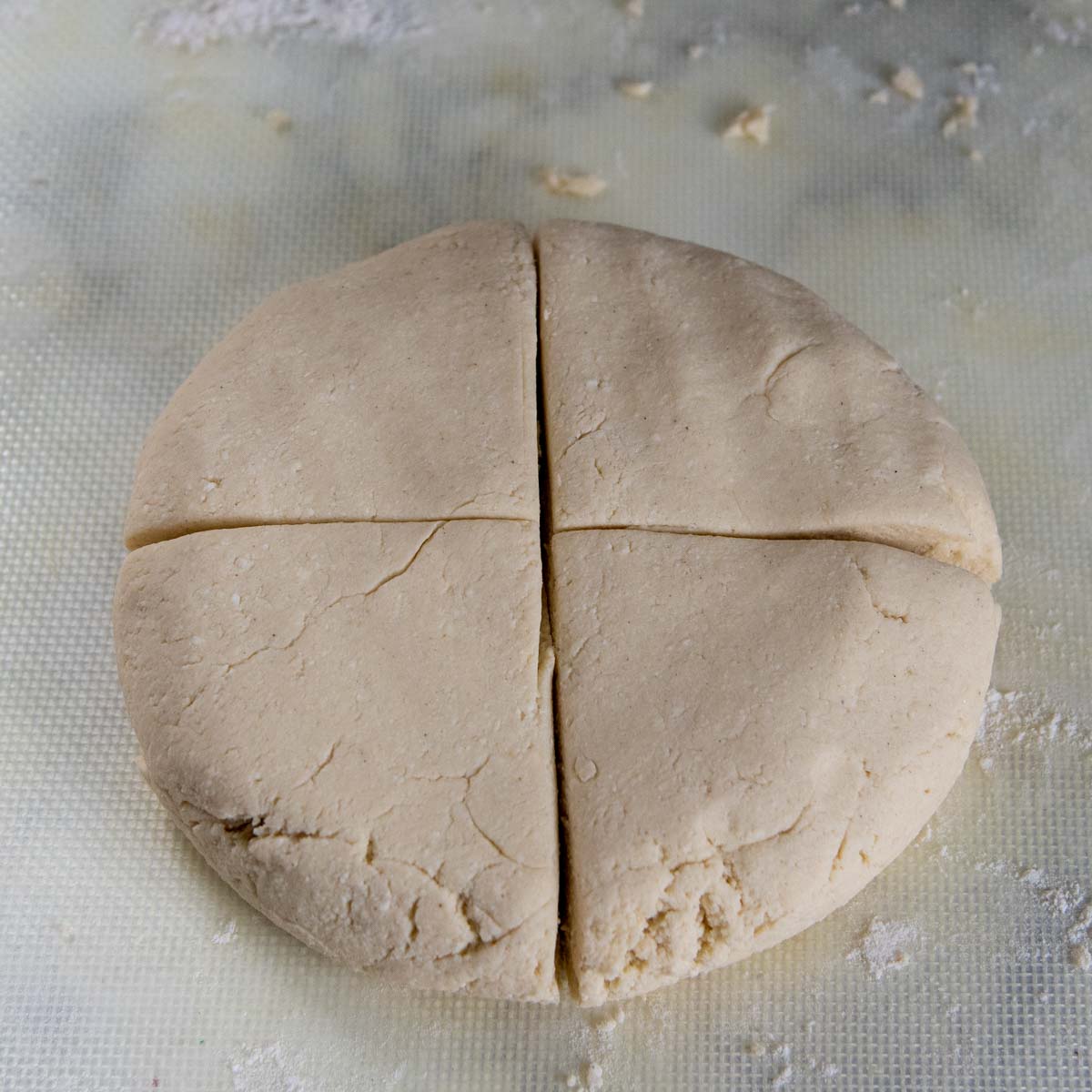

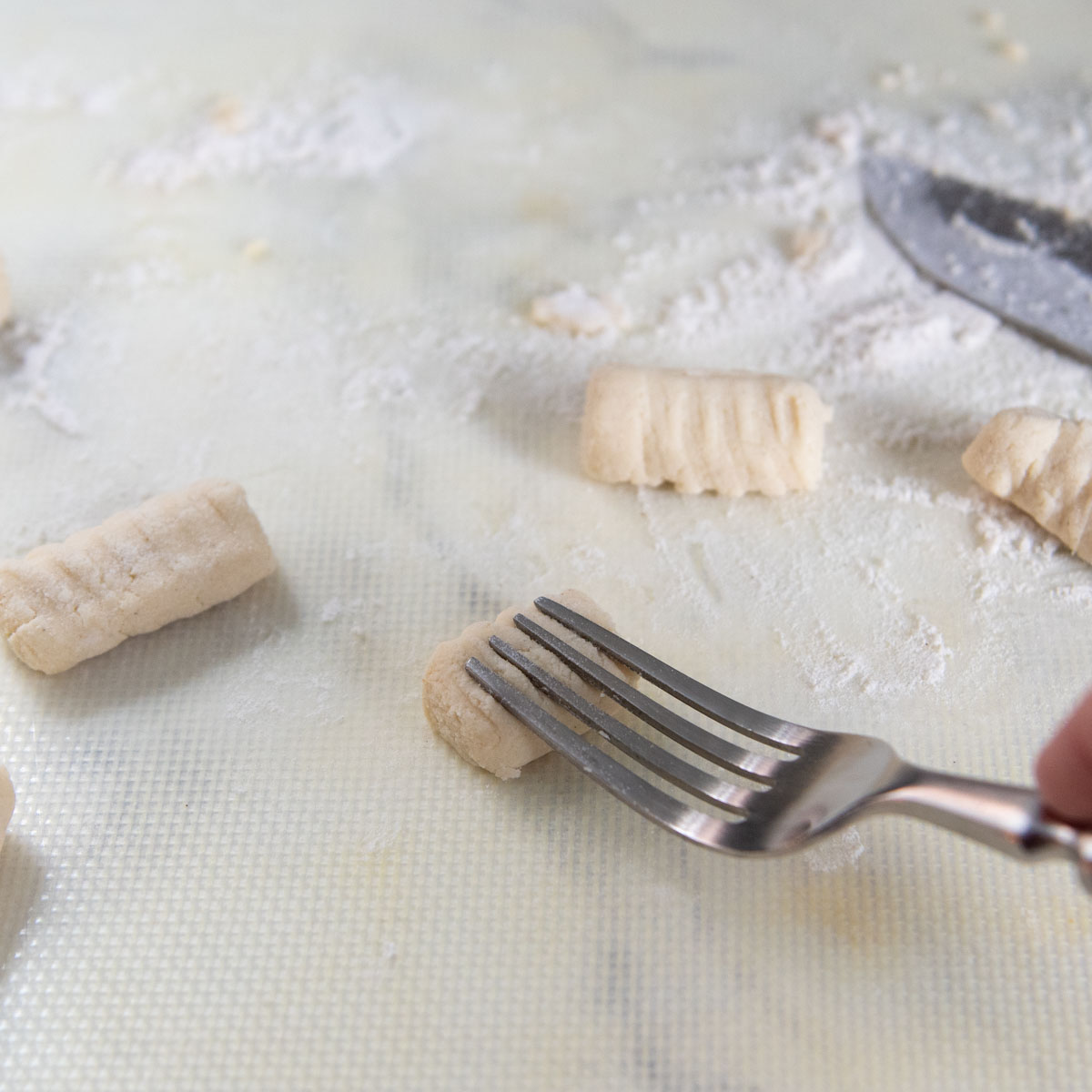
- In a large bowl whisk together ricotta, egg, olive oil, and parmesan. Stir in 2 cups gluten-free flour blend into the dairy mixture until it’s well mixed and the dough comes together.
- Turn the dough out onto a lightly floured surface. Knead it together until it becomes a smooth ball. Flatten the ball into a thick disc and cut into 4 sections.
- Roll two sections into long ropes. Cut 2 ropes at one time in ½” pieces. If desired, use the tines of a fork to make ridges. Transfer the cut gnocchi to a baking sheet and repeat with the remaining 2 sections.
- Boil water in a medium sauce pan. Cook the pieces of dough in small batches, about 1/8 of the batch at a time. Add the gnocchi in the boiling water, give a brief stir to prevent sticking, and then cook until they rise to the top and are fork tender.
- Use a slotted spoon or skimmer to lift the cooked gnocchi out into a large colander. Repeat with the remaining pasta. Immediately serve or toss with butter or tomato sauce.
boiling gluten-free gnocchi
I don’t recommend adding salt to the boiling water when cooking gluten-free pasta. The salt absorbs in the starches too much, making an overly salty dish.
When cooking gnocchi, they are normally pulled from the boiling water as soon as they float to the top. However, with GF gnocchi it’s best to let them boil 30-45 seconds longer after floating to the top to ensure they’re fully cooked. Undercooked gnocchi will taste grainy and unpleasant.
recommended gluten-free flour
Unfortunately not all gluten-free flours are created equal and perform differently depending on the recipe. For more information on which GF flour to use with varying recipes, check out my best gluten-free flour post.
Therefore, when testing homemade gluten-free gnocchi, I wanted to make sure the results would be consistent depending on the flour. Unfortunately they were not.
THE RESULTS:
King Arthur Measure-for-Measure Gluten Free Flour – Came together and rolled nicely. However, it tasted doughy and grainy after boiling with an unpleasant taste. When I tried cooking it in a sauce, the gnocchi was mushy and did not hold shape.
Bob’s Red Mill 1-to-1 Gluten Free Flour – Similar results as King Arthur. The shape held together, but the ricey, grainy taste was very unpleasant.
Cup4Cup Gluten Free Flour (winner) – Came together and rolled nicely. The first time I added a little too much flour and the bite was a little gelatinous, even though the taste was good. The second time I only added about 1 tablespoon additional flour, just enough so the dough wasn’t sticky. The texture was much better and the taste had no hint of “gluten-free.” The gnocchi also performed well in boiling water or cooked in a sauce.
Cup4Cup gluten-free flour also works well in other Italian dishes, such as gluten-free manicotti with homemade crepes, focaccia, and homemade pasta noodles.
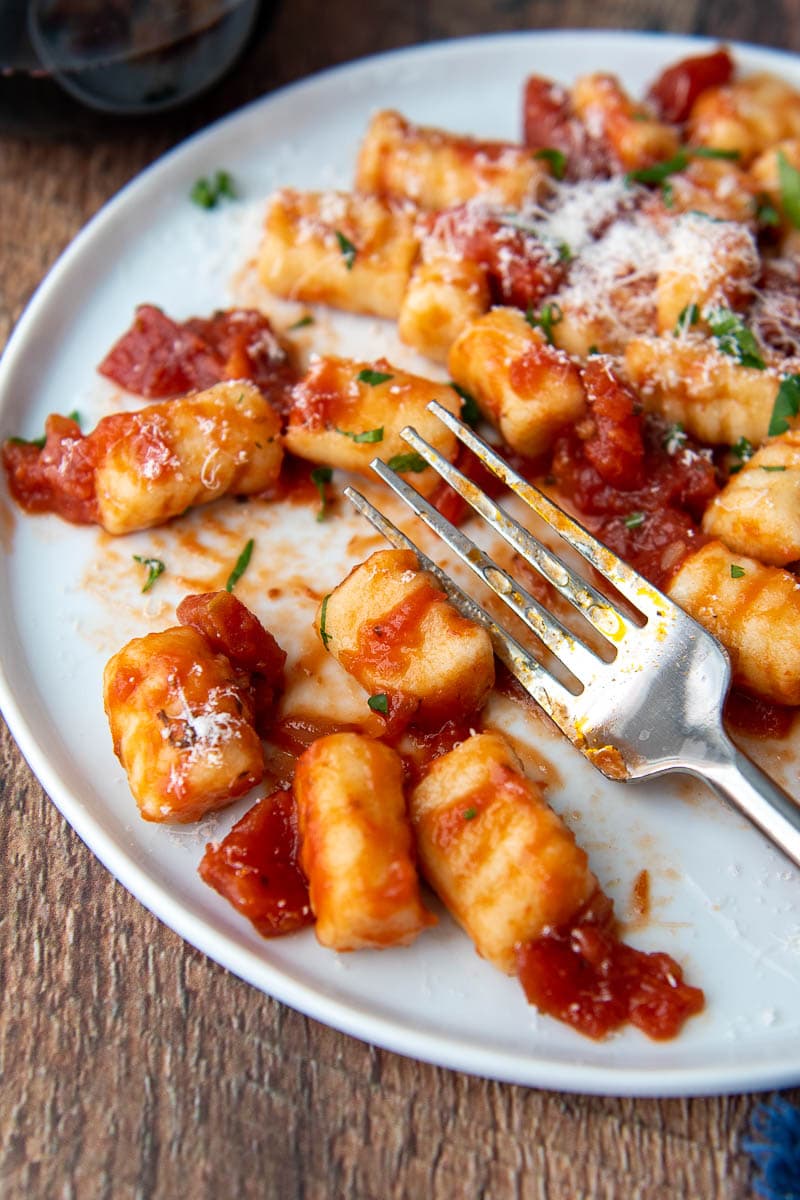
shaping gnocchi
Gnocchi doesn’t necessarily have to be shaped, meaning the ridges pressed into them. This is done so the sauce seeps into the groves.
In fact, my Gramma never did this, and I don’t either because it’s just an extra step and time. However, if you do want authentic-looking homemade gnocchi, use the tines of fork or a gnocchi board.
cooking fresh gnocchi in a sauce
You may cook gluten-free gnocchi in a sauce, rather than boiling water, but it works best if you used Cup 4 Cup gluten free flour . When I tried this with pasta made from other flours, it broke down and became mushy.
boiling from frozen
After being cut, the gnocchi may be frozen on baking sheets and then transferred to a ziplock freezer bag once solid.
To cook, add less gnocchi to the water than with freshly made gnocchi. Too much frozen pasta at once will drastically reduce the water temperature, so they will become mushy as they cook longer.
More ways to enjoy
- Sauté in garlic butter (cook in boiling water first)
- Served with marinara or bolognese
- Dumplings in soups
- Cooked in a sauce, instead of boiling separately
- Serve alongside other easy gluten-free Italian recipes, such as eggplant boats or gluten-free focaccia.
Click here to see the
step-by-step web story instructions for this recipe!
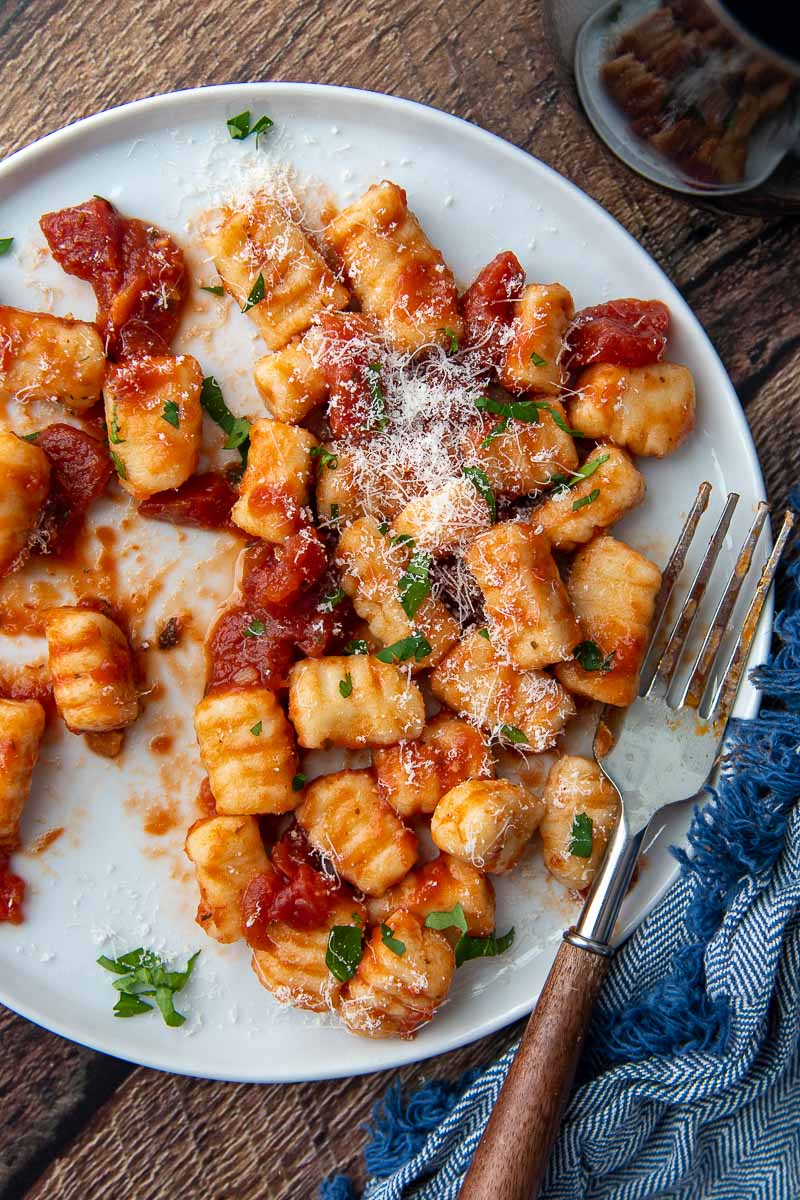
Save this easy gluten-free gnocchi recipe to your PINTEREST board!
Let’s be friends on Pinterest! I’m always sharing great recipes!
30-Minute Gluten-Free Ricotta Gnocchi Recipe
Equipment Needed
Ingredients
- 15 ounce whole milk ricotta
- 1 egg
- 1 tablespoon olive oil
- ¼ cup finely grated parmesan cheese
- 2 cups all purpose gluten-free flour (Cup 4 Cup highly recommended), plus more for rolling dough
Instructions
- In a large mixing bowl whisk together ricotta, egg, olive oil, and parmesan cheese. Stir in 2 cups flour until well mixed and the dough comes together.15 ounce whole milk ricotta,1 egg,1 tablespoon olive oil,¼ cup finely grated parmesan cheese,2 cups all purpose gluten-free flour (Cup 4 Cup highly recommended),
- Turn the dough out onto a lightly floured surface or silicone rolling mat. Knead the dough together until it becomes a smooth ball. If necessary, sprinkle a little more flour in (1-4 tablespoons) until the dough just no longer sticks to your hands.
- Flatten the ball into a thick disc and cut into 4 sections. Roll two sections into long ropes, about 1 inch thick.
- Carefully rub a little flour on a sharp knife blade and cut 2 ropes at one time in ½" pieces. If desired, use the tines of a fork to make indentations. Transfer the cut gnocchi to a baking sheet and repeat with the remaining 2 sections.
- If preparing straight away, transfer the baking sheets to the refrigerator while a large pot of salted water boils. Otherwise, transfer the baking sheets to the freezer to freeze until solid, then transfer to airtight ziplock bag.
- Boil the gnocchi in small batches, about 1/8 of the recipe at a time. Add the gnocchi to the boiling water, give a brief stir to prevent sticking, and then cook until they rise to the top. TIP: For gluten free gnocchi, it's best to leave them in about 30-45 seconds longer after rising to make sure they are cooked through.
- Use a slotted spoon or skimmer to lift the cooked gnocchi out into a large colander. Repeat with the remaining pasta. Immediately serve or toss with desired sauce.
- DID YOU MAKE THIS RECIPE?? DON'T FORGET TO LEAVE FEEDBACK AND/OR CLICK A STAR RATING ON THE RECIPE CARD!
Recipe Notes
How Much Does it Make?
Store bought gnocchi is often sold in one pound packages, which is what most recipes call for. Gluten free ricotta gnocchi makes approximately 2 pounds, but you can always freeze half for later!Important tips:
- Cup 4 Cup Gluten Free Flour is highly recommend and yields the best taste and texture. However, the pasta will become a little gelatinous if too much flour is added, so add just enough so the dough losses it stickiness, about 1-2 tablespoons more. Always spoon and level the flour into the measuring cup for best results.
- Freezing – After being cut, the gnocchi may be frozen on baking sheets and then transferred to a ziplock freezer bag once solid. Freeze up to 3 months. TO COOK: add less gnocchi to the water than with freshly made gnocchi. Too much frozen pasta at once will drastically reduce the water temperature, so they will become mushy as they cook longer.
- Can I cook fresh in a sauce? Yes, but this works out best if you used Cup 4 Cup gluten free flour to make your ricotta gnocchi. When I tried this with pasta made from other flours, it broke down and became mushy.
- How much does this recipe make? Makes approximately 2 pounds, but you can always freeze half for later!
Nutrition
This post contains affiliate links. My opinions are always my own. If you purchase a product through an affiliate link, I make a small commission – at no cost to you. Read full disclosure policy here.

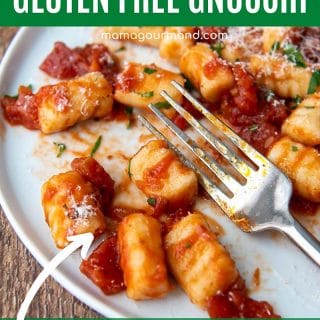
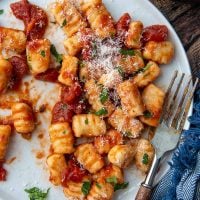
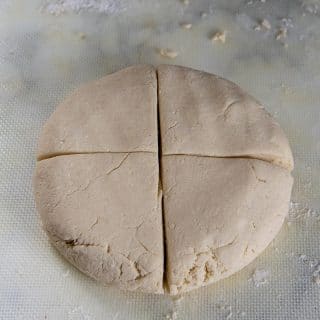
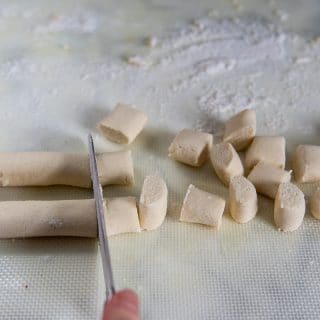
Christina Maffia says
We made these today and they were DELICIOUS!!! Half the recipe was enough for two for dinner; I was able to freeze the other half for another night!!Thank you for another gluten free recipe!
Melissa Erdelac says
So happy to hear, Christina. Thanks for taking the time to share!
Best,
Melissa
Elizabeth says
I made this tonight and it was delicious! I boiled the gnocchi and then sauteed them in lemon garlic butter with shrimp. I used the Cup4Cup flour as suggested. Next time I will let the gnocchi boil for another 30 seconds or so; they were just a touch underdone. I’m at high altitude, so I’m not sure if that affected the cooking time. They tasted great in the end — butter always helps, right?
I’ve never made gnocchi before and it was easier than I expected — still a bit of a project, but doable. I’m bookmarking this recipe and can’t wait to check out your other ones!
Melissa Erdelac says
Hi Elizabeth,
I’m so happy to hear! Yes, it’s not something you can do on busy weeknights, but I do think it’s a lot easier and less intimidating than it may seem. Thanks for taking the time to write.
Best,
Melissa